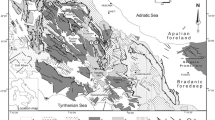Abstract
This paper presents a study on the gravity-induced rock slope deformation observed along the Nujiang River in China. We performed a comprehensive field investigation and analysis to identify the deformation pattern of the slope and its triggering factors. Moreover, a geological-evolutionary model was developed, and it considers the effects of river incision and rock mass degradation caused by weathering and simulates the mechanisms underlying the initiation and progression of the slope deformation. The results support the proposed failure mechanism in which fractures within the slope are induced by rock mass degradation caused by weathering. Importantly, the modeling reveals that compressional deformation at the toe of the slope results in a tensile failure in the upper portion of the slope, demonstrating that the rock mass in the slope toe is the key factor inducing slope deformation. This analysis of slope deformation and its spatial and temporal correlations with rock weathering and river incision reveal the main triggering factors that control the evolution of the studied slope and provide insights into the deformation process.
Similar content being viewed by others
References
Agliardi F, Crosta G, Zanchi A (2001) Structural constraints on deep-seated slope deformation kinematics. Engineering Geology 59: 83–102. https://doi.org/10.1016/S0013-7952(00)00066-1
Arsenault AM, Meigs AJ (2005) Contribution of deep-seated bedrock landslides to erosion of a glaciated basin in southern Alaska. Earth Surface Processes & Landforms 30: 1111–1125. https://doi.org/10.1002/esp.1265
Bozzano F, Bretschneider A, Martino S (2008) Stress–strain history from the geological evolution of the Orvieto and Radicofani cliff slopes (Italy). Landslides 5: 351–366. https://doi.org/10.1007/s10346-008-0127-2
Burbank D W, Leland J, Fielding E, et al. Bedrock incision, rock uplift and threshold hillslopes in the northwestern Himalayas. Nature 379: 505–510. https://doi.org/10.1038/379505a0
The Ministry of Water Resources of the People's Republic of China (1999) Code for Water Resources and Hydropower Engineering Geological Investigation (GB 50287-99). (In Chinese)
Crosta G (1997) Landslide, spreading, deep seated gravitational deformation: analysis, examples, problems and proposals. Supplements of Physical Geography and Dynamic Quaternaria 19: 297–313.
Engelen GB (1963). Gravity tectonics in the north-western Dolomites (N Italy). Geol Ultraiectina 13:5–91.
Fortsakis P, Nikas K, Marinos V, et al. (2012) Anisotropic behaviour of stratified rock masses in tunnelling. Engineering Geology 141–142: 74–83. https://doi.org/10.1016/j.enggeo.2012.05.001
Hippolyte J C, Bourlès D, Braucher R, et al. (2009) Cosmogenic 10 Be dating of a sackung and its faulted rock glaciers, in the alps of savoy (France). Geomorphology 108: 312–320. https://doi.org/10.1016/j.geomorph.2009.02.024
Hu GK, Zheng QS, Huang ZP (2001) Micromechanics methods for effective elastic properties of composite materials. Advances in Mechanics 31: 361–393.
Goldich SS (1938) A Study in Rock-Weathering. The Journal of Geology 46: 17–58.
Goodman RE (1989). An introduction to rock mechanics. Engineering Geology 19: 72–74.
Hou YL, Chigira M, Tsou CY (2014) Numerical study on deepseated gravitational slope deformation in a shale-dominated dip slope due to river incision. Engineering Geology 179: 59–75. https://doi.org/10.1016/j.enggeo.2014.06.020
Kellerer-Pirklbauer A, Proske H, Strasser V (2010) Paraglacial slope adjustment since the end of the Last Glacial Maximum and its long-lasting effects on secondary mass wasting processes: Hauser Kaibling, Austria. Geomorphology 120: 65–76. https://doi.org/10.1016/j.geomorph.2009.09.016
Luzio ED, Saroli M, Esposito C, et al. (2004) Influence of structural framework on mountain slope deformation in the Maiella anticline (Central Apennines, Italy). Geomorphology 60: 417–432. https://doi.org/10.1016/j.geomorph.2003.10.004
Marinos P, Hoek E (2001) Estimating the geotechnical properties of heterogeneous rock masses such as flysch. Bulletin of Engineering Geology & the Environment 60: 85–92. https://doi.org/10.1007/s100640000090
McQueen KG, Scott KM (2008) Rock weathering and structure of the Regolith. In: Scott KM, Pain CF (eds.), Regolith science. CSIRO Publishing, Melbourne. pp 103–124
Monteleone S, Sabatino M, Bambina A (2010) Genesis and geomorphological evolution of deep-seated gravitational slope deformations: An example of dating in western sicily. Supplements of Physical Geography and Dynamic Quaternaria 33: 187–192.
Moro M, Saroli M, Salvi S, et al. (2007) The relationship between seismic deformation and deep-seated gravitational movements during the 1997 Umbria–Marche (Central Italy) earthquakes. Geomorphology 89: 297–307. https://doi.org/10.1016/j.geomorph.2006.12.013
Shrestha HK, Yatabe R, Bhandary NP (2008) Groundwater flow modeling for effective implementation of landslide stability enhancement measures. Landslides 5: 281–290. https://doi.org/10.1007/s10346-008-0121-8
Stéphane B, Chemenda AI, Darnault R, et al. (2012) Evolution of gravity-driven rock slope failure and associated fracturing: geological analysis and numerical modeling. Tectonophysics 526–529: 157–166. https://doi.org/10.1016/j.tecto.2011.12.010
Utili S, Crosta GB (2011) Modeling the evolution of natural cliffs subject to weathering: 1. limit analysis approach. Journal of Geophysical Research Earth Surface 116: 387–404. https://doi.org/10.1029/2009JF001557
Zishinsky U (1966) On the deformation of high slopes. 1st ISRM Congress. International Society for Rock Mechanics, Lisbon. vol. 2. pp 179–185.
Acknowledgements
This work is Supported by the National Natural Science Foundation of China(Grant Nos. 41521002,41572283 and 41130745),and also supported by the Funding of Science and Technology Office of Sichuan Province (Grant Nos. 2015JQ0020).
Author information
Authors and Affiliations
Corresponding author
Rights and permissions
About this article
Cite this article
Zhu, L., Huang, Rq., Yan, M. et al. Geological analysis of gravitational rock slope deformation: a case from Nujiang River, China. J. Mt. Sci. 14, 2122–2133 (2017). https://doi.org/10.1007/s11629-016-4261-3
Received:
Revised:
Accepted:
Published:
Issue Date:
DOI: https://doi.org/10.1007/s11629-016-4261-3




